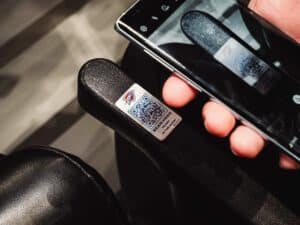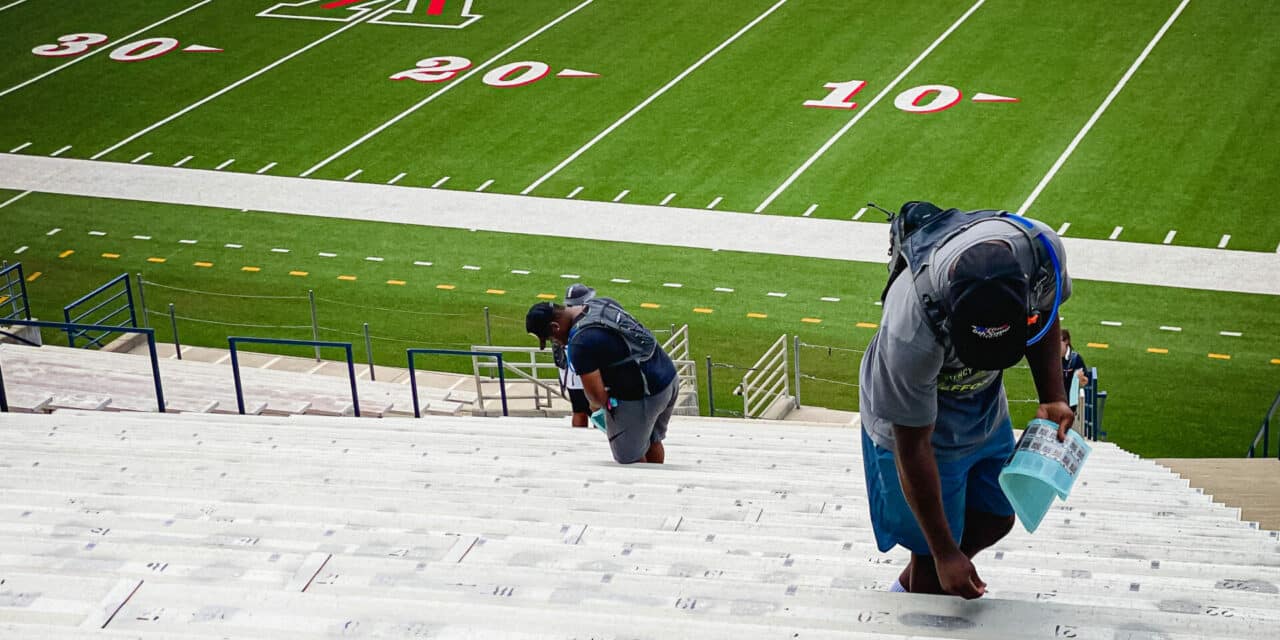STICKY SEAT: Fresno State University is among college sports programs using Digital Seat technology at Valley Children’s Stadium, their football facility. (Courtesy vendor)
Fan engagement tool identifies individual seats
The sports technology market is flooded with fan engagement tools as teams and venues strive to capture as much data as possible about their customers to drive incremental revenue and better serve their needs.
Digital Seat Media, among those platforms, has gained solid traction since the company was founded in 2018 in Fort Worth, Texas. The firm has installed more than one million QR code tags on individual seats across 50 big league and college venues, company officials said.
The key to Digital Seat is its ability to track fan behavior down to the individual seat number, a critical detail other fan engagement platforms don’t have in place, according to Rob Steeger, Digital Seat’s chief strategy and business development officer.
To activate the system, fans use their mobile device to scan the QR code attached to their armrest on a fixed seat in an arena or a stadium bench seat. A portal pops up with a variety of functions to explore, extending from real-time game information, fan polls and surveys and enter-to-win sweepstakes, to augmented reality filters and mobile coupons provided by team sponsors.
In premium spaces, the codes are placed on small metal stands inside the suite hospitality area.
The technology is also equipped to integrate with mobile ordering systems for concessions and merchandise.
Digital Seat doesn’t revolve around a mobile application. It’s a progressive web application with the look and feel of a native web application typically found on cell phones and other mobile devices. The firm’s preferred business model is a yearly licensing fee paid by clients. In some cases, there may be a revenue share with the venue or the team to sell sponsorships for the platform, Steeger said.
“We are a hardware and software company designed to function in low bandwidth environments,” said Steeger, a veteran sports marketer whose experience covers American Express, Mastercard, the USTA and Learfield. “What we want is all fans, regardless of their affinity, to engage and make it easy for venues to deliver content.”
This past bowl season, Digital Seat codes were installed at the R+L Carriers New Orleans Bowl at the Caesars Superdome; the Guaranteed Rate Bowl at Chase Field; and the Vrbo Fiesta Bowl at State Farm Stadium. At those three events, the codes were provided on video screens to scan instead of attaching them physically to the seats, Steeger said.
It was the second year that the VRBO Fiesta Bowl used Digital Seat’s platform and engagement increased across the board across three levels of measurement.
For the New Year’s Eve game, in which TCU beat Michigan in the College Football Playoff semifinals, there were 20,768 “loads” of QR codes, accounting for 32% of the total crowd loading Digital Seat during the event.
All told, there were 67,000 fan module engagements, up from 55,000 at last year’s Fiesta Bowl, a 22% increase, according to Digital Seat officials. Module engagements refers to the number of times users of the technology clicked on modules inside the platform, such as statistics and game rosters, among other features.
Most important for Fiesta Bowl officials, they collected 6,060 leads, a big spike over the previous year’s total of 1,567 leads, which they can use for the purposes of remarketing products and services to those attendees that used the platform, Digital Seat officials said.
Officials said the increase in measurements were largely due to game attendance of 71,723, much higher than the crowd of 49,550 for the previous Fiesta Bowl, when Oklahoma State beat Notre Dame.
Two NBA teams, the Oklahoma City Thunder and Utah Jazz, both use Digital Seat.

THUNDEROUS APPLAUSE: The Oklahoma City Thunder uses Digital Seat to get a better grasp on attendees at Paycom Center. (Courtesy vendor)
The Thunder signed a three-year deal with the firm in 2021, and are in the process of replacing existing codes with newer ones as the arena installs all new seats in the bowl, said Scott Loft, the team’s vice president of ticket sales, member services and business intelligence.
“I’ve been with teams for 35 years and the one thing we’ve never been able to get hold of is everyone in the building,” Loft said. “When everything went digital, that helped with transfer and resale data, but if you decide to bring your family of four and keep all the tickets on your phone, we don’t have information for the other three people with you.”
Not every fan uses the Thunder’s mobile app but all ticket holders have a unique QR code attached to their seat at Paycom Center. The Thunder averages 2,000-plus scans a game in the 18,200-seat venue and half come from individuals new to their database, Loft said.
“The adoption rate is better than we expected,” he said. “If we can gain 40,000 (new entries) over the course of the season of people that attend games, that feels enormous for us and gives us an opportunity to market our products to them; not just tickets, but merchandise and basketball campus, etc. We view it as a big plus.”
At Paycom Center, the mobile ordering function runs through Savor for general concessions and Levy for premium dining in the suites and clubs, in tandem with tech vendor Shift4. To date, Loft said it has been used minimally for fans ordering food and drink on their phones for pickup at concession stands with express lines. In that respect, the Digital Sign program falls in line with low adoption in general for mobile ordering at sports venues. (Fans can also use the Thunder app for mobile ordering.)
Baylor University, among Digital Seat’s college clients, is in the second year of using the technology at its football, basketball, baseball and softball venues.
For the Big 12 school and Baylor Bear Sports Properties, the Learfield entity that holds multimedia rights, the QR codes are mostly used as a tool to drive sponsors’ exposure on game days, said Matt Iazetti, Baylor Bear Sports Properties’ general manager in Waco, Texas.
At McLane Stadium, Baylor’s football facility, Digital Sign allows the school to streamline game presentation scripts and post the codes on the videoboard multiple times as a reminder to help promote fan interaction.
“We had a promotion for a QSR in football last season where we highlighted a ‘section battle’ and the winning section had a 70% scan rate of the code,” Iazetti said. “To get 70% of people in a section to do anything is difficult, but in this case, providing a good offer and an interactive way for people to participate during the game went well.”
Baylor Bear Sports Properties is in the early stages of analyzing the fan data collected through Digital Seat. For now, the focus is on promoting the athletic department sponsors, including the eight partners in football, Iazetti said.
“We’ve only started to tap into the potential for getting fans to interact and improve their experience,” he said. “The goal is to continue to upgrade it and clean up the game scripts by not having things that clutter up the breaks and pump up the fans when we need them to get emotional.”
Loft got his start in sports biz in 1988 with the Philadelphia 76ers and remembers using the old Dun & Bradstreet cards printed from a dot matrix machine that had to be ripped apart to be shared for sales leads. Fast forward to 2023 with Digital Seat and the data goes directly into the Thunder’s CRM system where sales campaigns are set up and team officials can contact prospects the next morning.
“We always like being in front of things if we can,” Loft said. “We enjoy this platform and the deep data we can get and know that we can identify seat by seat what people’s likes are. We can start seeing those trends. It’s not just the data, but reacting to the data. That’s the key.”







